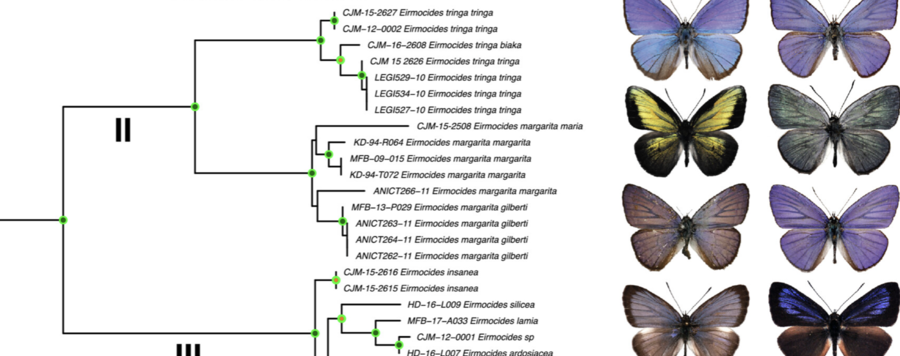
Four species in one: taxonomic revision of the Eirmocides helenita (Semper, 1879) complex (Lepidoptera: Lycaenidae) from Australia and New Guinea
Taxonomic investigations of the Eirmocides helenita (Semper, 1879) complex from north-eastern Australia and mainland New Guinea based on adult morphology (male genitalia and wing colour pattern elements), together with a phylogenetic hypothesis of the genus (18 or 69% of the recognised species) based on molecular data (1 mitochondrial and 12 nuclear genes), and examination of type material, indicate that there are five species within this monophyletic lineage, here referred to as the E. helenita species-group. Four of the species, previously classified under the name Eirmocides helenita (Semper, 1879) sensu lato and characterised by iridescent turquoise dorsal colouration in the male, are predominantly allopatric, as follows: Eirmocides callainus Braby & Müller, sp. nov., is endemic to the Wet Tropics biome of north-eastern Queensland; Eirmocides helenita (Semper, 1879) sensu stricto is restricted to Cape York Peninsula of northern Queensland; Eirmocides rouku Braby & Müller, sp. nov., is endemic to the Western Province of southern Papua New Guinea; and Eirmocides dimorphus (Röber, 1886), stat. rev., occurs more widely throughout mainland New Guinea and its adjacent islands. The fifth member of the group, Eirmocides cupreus (Röber, 1886), is sympatric with E. dimorphus on mainland New Guinea. The taxonomic revision brings to 26 the total number of species recognised in Eirmocides and within the tribe Candalidini to 40 species. Lectotypes are designated for Plebeius dimorphus Röber, 1886, Plebeius dimorphus var. cupreus Röber, 1886, and Holochila subargentea Grose-Smith & Kirby, 1896.





